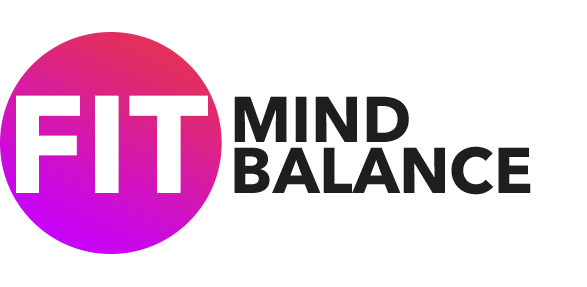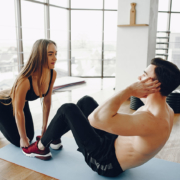1. Identify your “why,” “what,” and “how” so you can be clear about your goals (you can even write these down)
“The first step is truly taking the time to figure out your why, what, and how. The questions I ask my clients are: Why are you adding fitness and wellness into your life now? In what ways will your life be different when you have fitness in your life on a regular basis? And how are you going to include fitness into your lifestyle today, and this week? Once you know the why, what, and how, the mindset is ‘just do it.’ Nike got it right with that one.”
2. Try starting with three 30-minute workouts a week to pace yourself
“If you are just starting a new workout program, don’t overcommit or over-perform! Try starting with three days a week, and schedule it into your week like a doctor’s appointment. No need to take a full class—stay for 30 minutes, or try a short private training session or an at-home workout. You want to make sure you are working yourself into shape safely and effectively. Then, after week four, try adding another 30 minutes every other week. You’ll be surprised how empowered you’ll feel!”
3. Prioritize consistency over intensity
“You are better off doing a 45-minute, moderate-intensity strength circuit three times per week than to do a two-hour, high-intensity workout six times a week, and then burning out in three weeks because it’s not sustainable. And remember that it takes time and consistency to build your body, but one workout can put you in a better mood. You leave it all in the gym: the annoying boss, the argument with your best friend, being stuck in traffic… It’s like you get to press reset.”
4. Find other active people to support your efforts
“Motivation is what gets you started, but making things a habit is how you keep the longevity of an active lifestyle. Having friends, family, and coworkers that exercise with you can help you to persevere. Try to find workout buddies to do healthy things together. Also, what you do outside the gym will have a big influence on the workouts you do inside the gym—making positive changes in your nutrition, hydration, sleep, and stress levels will create big results.”
5. Do workouts you actually like — you’re more likely to stick with it
“My best advice for beginners is to find something you enjoy and focus on small, incremental progress each day. I believe that we get the best results from consistency, and in order to be consistent we need to enjoy the journey. That’s why I like to focus on small daily goals—small goals completed each day make for big progress over time and give us a sense of accomplishment daily.”
6. Invest in a great pair of shoes
“Wearing old, broken-down shoes can negatively impact your joints and ligaments, especially if you’re running, sprinting, or doing plyometrics. So selecting the correct shoes for your workout is important: For instance, tennis shoes are built for lateral movements. If you’re lifting weights, you will want a harder, flatter bottom of your shoe so you feel more connected to the floor. And if you are a runner, most specialty running stores will give you a stride assessment to help decide what shoes are best for your arch, heel strike, and foot width. Invest in the shoe that can be as diverse as possible in the gym and outside, but gives you the correct support your foot needs.”
7. To avoid burnout and injury, start slow and take breaks during your workouts
“Start slow, set realistic goals, be gentle with your body and take breaks as often as necessary. Making the commitment to begin a new workout is hard enough, so if you’re not honest about your physical fitness level and go too hard, you’re setting yourself up to potentially burn out or get injured, and that’s so far from the intended goal.”
8. Accept that you’ll have setbacks, and that’s OK
“Be patient with yourself—you will have setbacks, and every day will not be perfect. The key is to be persistent and keep moving forward. The only thing constant in life is change, so we should be prepared to make changes to be the best version of ourselves.”
9. Think of working out as an act of self-care
“I always want my new clients to know that the journey they’re about to embark upon tends to be the road less traveled. Those mental battles are hardest to deal with in the beginning stages so stay humble, stay committed, and know that the benefits far outweigh any difficulties. Wake up every day and remind yourself that self-care in all forms is the best decision you can make.”
10. Don’t skip your warm-up and cool down
“Warm-up before starting your routine—a proper warm-up [with dynamic stretching] is important to get the body ready for injury-free movement. Take time to stretch after your workout, and take rest days. There’s plenty of time to build and progress. My other tips: Go into your new venture with a fun, can-do mentality. Set goals and reward yourself upon meeting them, like a massage, new gear, or a weekend away. Stay hydrated, and get yourself on a good nutrition plan—you need proper fuel in your body to succeed.”
11. Master fundamental movements like squats and lunges before getting fancy
“Keep it basic, and don’t over-complicate your workouts. Too often people skip foundational exercises for workouts that look cool and are trendy. Mastering the basics truly takes time, so don’t rush through. A progressive basic workout program including exercises like squats, rows, lunges, and chest presses totally work and get great results.”
12. Don’t compare yourself to people who are further along in their fitness journey
“Be willing to look silly and make mistakes without judging yourself. Keep trying, and with every workout you’ll get better and better. Remember, the goal is progress, not perfection. And in a group environment, don’t compare yourself to anyone else in the room. While others may move seamlessly and appear to have superhuman strength, remember that they were once beginners too. Don’t compare your chapter one to someone else’s chapter eleven.”
13. Know that results don’t happen right away, and that’s OK
“People come in with the expectation of long-term results happening fast, but people should look at fitness as a big picture and making exercise a part of their life routine, as opposed to an acute, momentary mindset. Also remember that working out is multi-faceted, and it’s the combination of healthy eating and training together that creates the best results.”
14. Tune into that post-workout high, and enjoy it
“Focus on the feels. Most fitness goals are long-term projects, but the one exception to this is how we feel, which can immediately and profoundly improve after a single workout. If you’re just starting out, tune into the positive vibes you feel after exercise and let that be your reward. Remember, even as a newbie, you’re only one workout away from a good mood.”
15. If you’re into numbers and stats, try wearing a heart-rate monitor to see how your body’s working in real-time
“I tell someone starting out to wear a heart rate monitor so they know how their body is responding to the physical stress of training. Workouts are much more fun if they make sense. That goes along with my motto: train smarter, not harder.” Quick note: A heart rate monitor is a device you wear that tells you your heart’s beats per minute, so you can check it in real-time during your workout. This gives you objective information about how hard your body is actually working, regardless of how hard you feel like you’re working, which is known as your rate of perceived exertion. How hard a workout feels can be influenced by factors like how much enjoy it, the temperature and humidity of the room you’re in, and more—but how you feel isn’t always entirely representative of how hard your body’s actually working.
16. Set athletic goals, like doing push-ups on your toes instead of your knees or running a certain distance
“Set something other than an aesthetic goal. This can be a certain amount of weight you want to try to squat with, a distance you want to run, or maybe you just want to be able to do a push-up on your toes [instead of your knees]. The issue with aesthetic goals is that they’re fleeting, and they won’t keep you engaged enough to continue working during those tough times when you want to quit. There’s no better feeling than accomplishing that goal. Trust me—that’s how I got into fitness!”
17. Nix excuses by laying out your workout clothes, signing up for workouts, and meal prepping fueling foods
“Make it easy for yourself not to find excuses. Lay your clothes out the night before or pack your bag. Sign up for classes or a trainer at the beginning of the week and put it in your calendar. Order your meals or meal prep or plan out your meals for the week, and make a list of go-to spots that have healthy food near your work, home, and gym. You could also sign up for a race—this gives you a specific training time frame. I know I can commit to things when there is a clear start and end date. It forces me to put in my best effort, and once I cross that finish line, I am overjoyed I accomplished it and ready for another challenge.”
18. Practice gratitude for what your body can do right now (no matter what your future goals are)
“Be grateful for where you are, right now, and have a clear picture of where you’d like to be. From there, take on a simple plan that aligns with your goals and doesn’t bore you to death… and tackle it one step at a time. And remember to enjoy the process. Getting too caught up in where you want to be can rob you of your joy, today. And that just sucks. Happiness isn’t something that should be reserved for some imagined future. Your body is an absolutely amazing thing. Take a few moments, every day, to appreciate that. Believe or not, that simple gratitude can help you create the strongest body of your life.”



